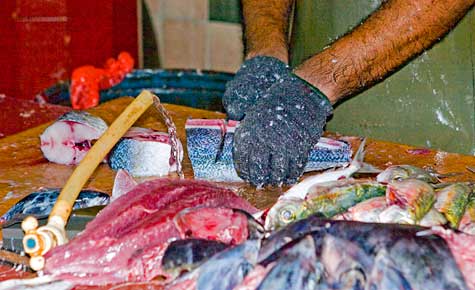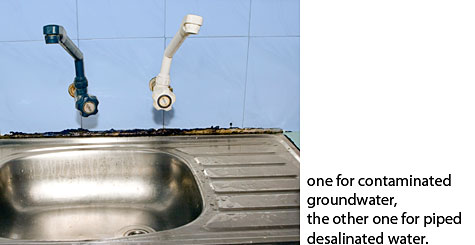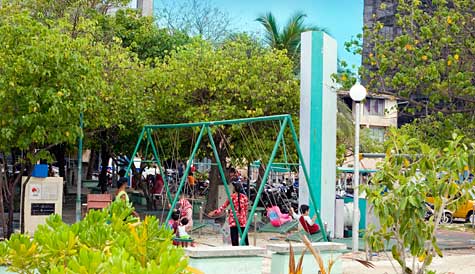FISH KEPT IN POLLUTED WATER FOR YOUR DINNER
Every day live fish such as Bigeye scad (Mushi mas) and Mackeral scad (Rimmas) are kept in cages in highly polluted Male’ inner harbour in front of the Fish Market. Local fishermen catch the fish from various areas and put them in the cages to be kept alive. These cages are kept in stagnated waters where oil and all sorts of trash from boats are accumulated. From the cages these fish are collected and put in baskets in Fish Market for selling.
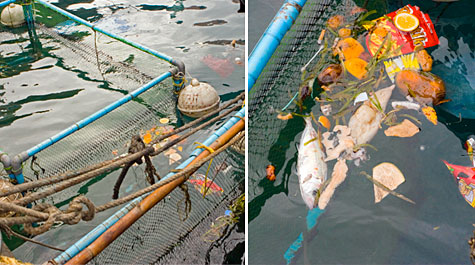
Cages in highly polluted water in front of Malé Fish Market.
Bigeye scad and Mackeral scad is commonly found in cafés and tea shops in Malé. They are also consumed at households. Some people who have bought Mackeral scad and Bigeye scad have complained of “kerosene-like taste†from these fish.

All sorts of trash accumulated near the cages in front of Fish Market.
Maldives Food and Drug Authority (MFDA), the competent authority established in 2006 to set the standards relating to food and drugs in Maldives, and the authority for certification of fish products to EU Market in the Maldives, while being completely aware of hygienic situation of fish sold in Fish Market in Malé, still allows live fish such as Mackeral scad and Bigeye scad to be kept in these cages and sold in Malé Fish Market.
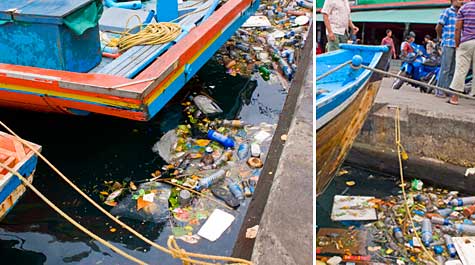
In the TVM evening news on March 15, MFDA admitted that it was aware of the unhygienic conditions in the Fish Market and surrounding areas. However, it has not taken any action to stop the selling of fish from the unhygienic fish cages in polluted waters.
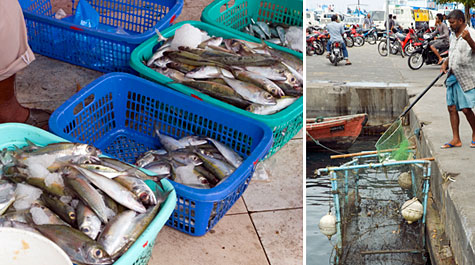
Fish from the cages are sold in the Fish Market.
Till very recently, contaminated groundwater was used at Fish Market for cleaning fish and washing the market floors.
According to the State of the Environment Report 2002, sewage effluent, potentially harmful substances and different chemicals are disposed untreated into coastal water of Malé, by means of nine outfalls at six different locations. “The pollution load from these sewer outfalls probably exceeds the dilution capacity of the receiving waters,” State of the Environment Report 2002 said.
Þ€Þ¦Þ‘Þ¨Þ‰ÞªÞ‘ÞªÞ‹Þ§ÞƒÞª Þ‰Þ¦ÞÞ° ÞˆÞ¨Þ‡Þ°Þ†Þ¦Þ‚Þ° Þ‰Þ§ÞƒÞªÞ†ÞÞ“ÞªÞŽÞ¦Þ‡Þ¨
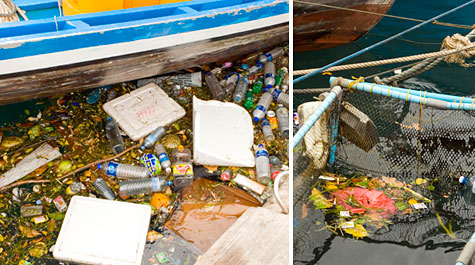
Þ‰ÞªÞÞ¨Þ‰Þ¦Þ€Þ§Þ‡Þ¨ ރިތްމަހަކީ Þ‰Þ§ÞÞÞŽÞ¬ ÞÞ¦Þ‡Þ¨ ހޮޓާތަކުގައި Þ¢Þ§Þ‡Þ°Þ‰ÞªÞ†Þ®ÞÞ° Þ€ÞªÞ‚Þ°Þ‚Þ¦ ބާވަތްތަކެކެވެ. Þ‡Þ¦Þ‹Þ¨ ÞˆÞ¦ÞƒÞ¦ÞÞ° ÞŽÞ¨Þ‚Þ¦ ÞŽÞÞŽÞÞŽÞ¦Þ‡Þ¨ ÞˆÞ¬ÞÞ° Þ†Þ¬Þ‡ÞªÞ‰Þ¦ÞÞ° Þ„ÞÞ‚ÞªÞ‚Þ°Þ†ÞªÞƒÞ§ Þ‡Þ¬Þ‡Þ°Þ—Þ¬Þ†Þ¬ÞˆÞ¬. Þ‰Þ§ÞƒÞªÞ†ÞÞ“ÞªÞ‚Þ° Þ‰ÞªÞÞ¨Þ‰Þ¦Þ€Þ§Þ‡Þ¨ ރިތްމަÞÞ° ÞŽÞ¦Þ‚Þ°Þ‚Þ¦ Þ„Þ¦Þ‡Þ¬Þ‡Þ° Þ‰Þ©Þ€ÞªÞ‚Þ° Þ‰Þ¦Þ€ÞªÞŽÞ¦Þ‡Þ¨ “Þ†Þ¦ÞƒÞ§ÞÞ©Þ‚Þª Þ†Þ¦Þ€Þ¦ÞÞ¦” ތެޔޮ ÞƒÞ¦Þ€Þ¦Þ‡Þ¬Þ‡Þ° Þ€ÞªÞ‚Þ°Þ‚Þ¦ Þ†Þ¦Þ‰ÞªÞŽÞ¬ ÞÞ¦Þ†ÞªÞˆÞ§ Þ†Þ®ÞÞ°ÞŠÞ¦Þ‡Þ¨ ÞˆÞ¬Þ‡Þ¬ÞˆÞ¬.
Þ‰Þ¯ÞÞ°Þ‘Þ¨ÞˆÞ°ÞÞ° ÞŠÞªÞ‘Þ° Þ‡Þ¬Þ‚Þ°Þ‘Þ° Þ‘Þ°ÞƒÞ¦ÞŽÞ° އޮތޯރިޓީ (Þ‡Þ¬Þ‰Þ°.Þ‡Þ¬ÞŠÞ°.Þ‘Þ©.Þ‡Þ) Þ‡Þ¦Þ†Þ© Þ‹Þ¨ÞˆÞ¬Þ€Þ¨ÞƒÞ§Þ‡Þ°Þ–ÞÞŽÞ¦Þ‡Þ¨ ކާބޯތަކެއްޗާއި Þ„ÞÞްތަކުގެ ÞŠÞ¬Þ‚Þ°ÞˆÞ¦ÞƒÞ§Þ‡Þ¨ ÞžÞ¨Þ‡Þ°Þ™Þ© މިންގަނޑުތައް Þ†Þ¦Þ‚Þ‘Þ¦Þ‡Þ¬Þ…ÞªÞ‰Þ¦ÞÞ°Þ“Þ¦Þ†Þ¦Þ‡Þ¨ 2006 ÞˆÞ¦Þ‚Þ¦ Þ‡Þ¦Þ€Þ¦ÞƒÞª Þ‡ÞªÞŠÞ¦Þ‡Þ°Þ‹Þ§ÞŠÞ¦Þ‡Þ¨ÞˆÞ§ ÞƒÞ¦ÞÞ°Þ‰Þ© Þ‡Þ¨Þ‹Þ§ÞƒÞ§ Þ‡Þ¬ÞˆÞ¬. Þ‰Þ¨Þ‡Þ© Þ”Þ«ÞƒÞ¦Þ•Þ¨Þ‡Þ¦Þ‚Þ° Þ”Þ«Þ‚Þ¨Þ‡Þ¦Þ‚Þ°Þ‡Þ¦ÞÞ° Þ‹Þ¨ÞˆÞ¬Þ€Þ¨ÞƒÞ§Þ‡Þ°Þ–Þ¬Þ‡Þ¨Þ‚Þ° Þ‡Þ¬Þ†Þ°ÞÞ°Þ•Þ¯Þ“Þ° Þ†ÞªÞƒÞ§ Þ‰Þ¦Þ€ÞªÞŽÞ¬ ބާވަތްތަކަÞÞ° ÞÞ¬Þ“Þ°ÞŠÞ¨Þ†Þ¬Þ“Þ° ÞƒÞ§Þ‡Þ°Þ–ÞÞŽÞ¦Þ‡Þ¨ Þ‹Þ«Þ†ÞªÞƒÞ§ Þ‡Þ¨Þ‹Þ§ÞƒÞ§ ÞˆÞ¬ÞÞ° Þ‰Þ¬Þ‡Þ¬ÞˆÞ¬. Þ‚Þ¦Þ‰Þ¦ÞˆÞ¬ÞÞ° Þ‡Þ¬Þ‡Þ¨Þ‹Þ§ÞƒÞ§Þ‡Þ¦ÞÞ° ÞˆÞ¬ÞÞ° Þ‰Þ¦ÞÞ° Þ‰Þ§ÞƒÞªÞ†ÞÞ“Þª ކުރިމަތީގައި ÞŠÞ¦Þ…ÞªÞŒÞ¬ÞƒÞ ÞžÞ¨Þ‡Þ°Þ™Þ© ގޮތުން Þ‡Þ¬Þ†Þ¦ÞÞ©ÞŽÞ¬Þ‚Þ°ÞˆÞ§ މިންގަނޑުތަކަÞÞ° Þ‚ÞªÞŠÞ¬ÞŒÞ Þ™Þ§Þަތުގައި Þ‰Þ¦ÞÞ° Þ‹Þ¨ÞƒÞªÞˆÞ¦Þ‡Þ¨ÞŽÞ¬Þ‚Þ° ÞˆÞ¨Þ‡Þ°Þ†Þ§Þ†Þ¦Þ‚Þ° Þ‡Þ¬ÞŽÞ¨ÞŠÞ¦Þ‡Þ¨ އޮތް Þ‚Þ¦Þ‰Þ¦ÞˆÞ¬ÞÞ° Þ‰Þ¨Þ†Þ¦Þ‰Þ¦ÞÞ° ÞŠÞ¨Þ”Þ¦ÞˆÞ¦Þ…Þ¬Þ‡Þ° Þ‡Þ¦Þ…Þ§ÞŠÞ¦Þ‡Þ¨ Þ‚ÞªÞˆÞ¬Þ‡Þ¬ÞˆÞ¬.
15 Þ‰Þ§ÞƒÞ—Þ° ÞˆÞ¦Þ‚Þ¦ Þ‹ÞªÞˆÞ¦Þ€ÞªÞŽÞ¬ ÞƒÞ Þ“Þ©ÞˆÞ© Þ‰Þ¯ÞÞ°Þ‘Þ¨ÞˆÞ°ÞÞ°ÞŽÞ¬ ÞšÞ¦Þ„Þ¦ÞƒÞªÞŽÞ¦Þ‡Þ¨ Þ‡Þ¬Þ‰Þ°.Þ‡Þ¬ÞŠÞ°.Þ‘Þ©.Þ‡Þ ÞŽÞ¬ ފަރާތުން ÞˆÞ¦Þ‚Þ© Þ‰Þ¦ÞÞ° Þ‰Þ§ÞƒÞªÞ†ÞÞ“Þ§Þ‡Þ¨ Þ‡Þ¦Þ‹Þ¨ Þ‰Þ§ÞƒÞªÞ†ÞÞ“ÞªÞŽÞ¬ Þ†Þ¦Þ‡Þ¨ÞƒÞ¨ ÞÞ¦ÞƒÞ¦Þ™Þ¦Þ‡Þ°Þ‹ÞªÞŽÞ¦Þ‡Þ¨ ÞžÞ¨Þ‡Þ°Þ™Þ© މިންގަނޑުތަކަÞÞ° Þ‚ÞªÞŠÞ¬ÞŒÞ Þ†Þ¦Þ‚Þ°ÞŒÞ¦Þ‡Þ° Þ€ÞªÞƒÞ¨ Þ†Þ¦Þ‰Þ¦ÞÞ° Þ€Þ§Þ‰Þ¦Þ†Þ®ÞÞ°ÞŠÞ¦Þ‡Þ¬ÞˆÞ¬. Þ‚Þ¦Þ‰Þ¦ÞˆÞ¬ÞÞ° ތަޣައްޔަރުވެފައިވާ ފަޅުތެރÞÞŽÞ¦Þ‡Þ¨ Þ‰Þ¦ÞÞ° Þ‹Þ¨ÞƒÞªÞˆÞ¦Þ‡Þ¨ ÞˆÞ¨Þ‡Þ°Þ†ÞªÞ‚Þ° Þ€ÞªÞ‡Þ°Þ“ÞªÞˆÞ§ÞÞ§ÞŠÞ¦Þ‡Þ¬Þ‡Þ° Þ‚ÞªÞˆÞ¬Þ‡Þ¬ÞˆÞ¬.
Þ‹Þ§Þ‹Þ¨ ÞŠÞ¦Þ€Þ¦Þ†Þ§Þ‡Þ¨ Þ–Þ¬Þ€Þ¬Þ‚Þ°Þ‹Þ¬Þ‚Þ° Þ‰Þ¦ÞÞ° Þ‰Þ§ÞƒÞªÞ†ÞÞ“ÞªÞŽÞ¦Þ‡Þ¨ Þ‰Þ¦ÞÞ° Þ‹Þ®Þ‚Þ°Þ‚Þ¦Þ‚Þ° Þ‡Þ¦Þ‹Þ¨ Þ‰Þ§ÞƒÞªÞ†ÞÞ“ÞªÞŽÞ¬ ތަޅުންގަނޑު ÞÞ§ÞŠÞªÞ†ÞªÞƒÞ¦Þ‚Þ° ÞˆÞ¬ÞÞ° Þ„ÞÞ‚ÞªÞ‚Þ°Þ†Þ®ÞÞ°ÞŠÞ¦Þ‡Þ¨ÞˆÞ¦Þ‚Þ© ތަޣައްޔަރުވެފައިވާ ÞŠÞ¬Þ‚Þ¬ÞˆÞ¬.
ÞÞ°Þ“ÞÞ“Þ° Þ‡Þ®ÞŠÞ° Þ‹Þ¨ Þ‡Þ¬Þ‚Þ°ÞˆÞ¦Þ”Þ¦ÞƒÞ¦Þ‚Þ°Þ‰Þ¦Þ‚Þ°Þ“Þ° ÞƒÞ¨Þ•Þ¯Þ“Þ° 2002 Þ„Þ¦Þ”Þ§Þ‚Þ° Þ†ÞªÞƒÞ§ ގޮތުގައި ނަޖިހާއި، ÞžÞ¨Þ‡Þ°Þ™Þ© ނުރައްކާތައް Þ‰Þ¬Þ‹ÞªÞˆÞ¬ÞƒÞ¨ÞˆÞ¬Þ‹Þ§Þ‚Þ¬ ÞŠÞ¦Þ‹Þ¦ ބާވަތްތައް Þ‡Þ¦Þ‹Þ¨ ތަފާތު Þ†Þ¬Þ‰Þ¨Þ†Þ¦Þްތައް Þ‡Þ¬Þ‡Þ°ÞˆÞ¬ÞÞ° ÞˆÞ¦ÞƒÞ¦Þ†Þ¦ÞÞ° Þ“Þ°ÞƒÞ©Þ“Þ° Þ‚ÞªÞ†Þ®ÞÞ° Þ‰Þ§ÞÞÞŽÞ¬ ÞˆÞ¦ÞÞ¦Þ‡Þ¨ÞŽÞ¬Þ‚Þ°ÞˆÞ§ Þ‰Þ«Þ‹Þ¦ÞÞ° Þ‹Þ«Þ†ÞªÞƒÞ¬ÞˆÞ¬Þ‡Þ¬ÞˆÞ¬. Þ‡Þ¬Þ‡Þ© ތަފާތު Þ€Þ¦ Þ‹Þ¨Þ‰Þ§ÞÞ¬Þ‡Þ°ÞŽÞ¦Þ‡Þ¨ Þ€ÞªÞ‚Þ°Þ‚Þ¦ 9 Þ€Þ®Þ…Þ¨Þ‚Þ°Þ‚Þ¬ÞˆÞ¬. Þ‡Þ¬ÞƒÞ¨Þ•Þ¯Þ“Þª ބުނާގޮތުން Þ‚Þ¦Þ–Þ¨ÞÞ° Þ„ÞÞƒÞªÞ†ÞªÞƒÞ§ ހޮޅިތަކުން Þ„ÞÞƒÞªÞ†ÞªÞƒÞ§ ބާވަތްތަކުގެ ÞÞ¦Þ„Þ¦Þ„ÞªÞ‚Þ° ތަޣައްޔަރުވާ މިންވަރު، Þ‡Þ¬ ބާވަތްތައް Þ‡Þ¬Þ…Þ ÞÞ¦ÞƒÞ¦Þ™Þ¦Þ‡Þ°Þ‹ÞªÞŽÞ¬ ÞÞ®Þ‚ÞªÞŠÞ¬Þ‚ÞªÞ‚Þ° އެބާވަތްތައް “Þ‘Þ¦Þ‡Þ¨ÞÞ¨Þ‡ÞªÞ“Þ°” Þ†ÞªÞƒÞ¬ÞˆÞ Þ‰Þ¨Þ‚Þ°ÞˆÞ¦ÞƒÞ¦ÞÞ° ÞˆÞªÞƒÞ¬ މަތިވާނެ Þ†Þ¦Þ‰Þ¦ÞÞ° ÞÞ¦ÞŠÞ§Þ†ÞªÞƒÞ¬ÞˆÞ¬Þ‡Þ¬ÞˆÞ¬.
